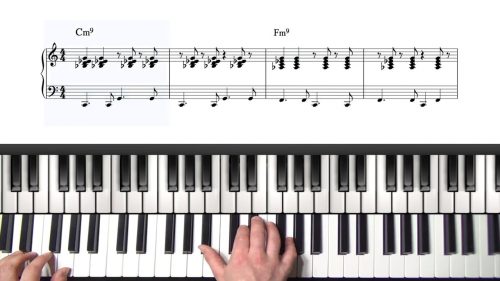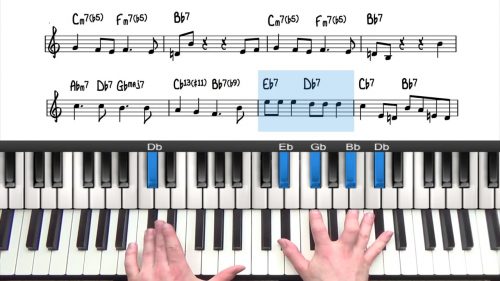Estate Jazz Piano Tutorial
Estate is an Italian song written by Bruno Martino. The tune made it’s way into the jazz standard repertoire thanks to the well know Brazilian singer, songwriter and guitarist: Joao Gilberto who created a bossa nova interpretation of the song.
It can be played both as a ballad and a bossa, but in this lesson we’re going to approach the tune with a ballad feel and we’ll be playing quite freely in places.
We’ll start off playing the first section with some simple spread voicings, outlining the roots 3rds and 7ths of the chords and the melody on top.
We’ll then play through again with extended and altered voicings to create a richer and more colorful harmonic palate.
We’ll also be adding in some melodic fills and decoration to keep things interesting when the melody or harmony is static.
Practice Tips
- Start with the root position 7th chords.
- After you get the foundations in place, start experiment with left hand voicings.






Of course, I always first listen to Chet…
Beautiful recordings Lori… the Chet and guitar combo is sublime!
Likewise his recordings are often the first place I go to when I’m learning a new tune. I hadn’t heard that version, it’s lovely.
And yes I’m a big fan of Toots – he had such a warm and upbeat sound. Check out “Affinity” which is a duo album with him and Bill Evans. They play a number of the tunes we have covered on PianoGroove including “Blue In Green”, “Days Of Wine & Roses” and also “Body & Soul”. It’s a real nice album… One of my favourites!
Last fall, I jammed with a jazz harmonica player in Vancouver, B.C. (he was naturally a big fan of Toots) and so we played all 3 of those tunes which was a lovely experience. We had a drummer but no bass player which suited me fine as I play mostly solo piano and so I had no problem including the root in my voicings.
Hayden, this piece of music and your arrangement is absolutely beautiful. I have listened to it multiple times — trying to get myself ready to learn it. I keep getting caught up in listening to it instead of learning…ha ha ha…Thanks for playing it completely through at the end of the video. Very beautiful and inspiring. I’m sure i’ll have some theory questions as I begin to actual start playing it.
Thanks Lonnie, I’m glad you like the arrangement.
I think that’s a very good way to start out with learning a new tune… listen to as many different versions as possible.
I always recommend that students get into the habit of this and so it’s great that you are doing this naturally. So much can be learnt from just listening!
Sure thing, any questions let me know :-)
Cheers,
Hayden
Instantly – loving this song! Amazing lesson – Thank you, Hayden!
Hi Hayden,
I have always loved this piece and was looking for the sheet music for a while and then “voila” found your gorgeous arrangement of it. Thank you!
Question and Request:
I sort of know the answer but with jazz arrangements, I find it really slows me down when a chord such as my “new favorite” chord combo (I hope my written explanation is clear – not always sure.)
F#13(sus4) -measure 27 gets written in the RH with the 2 flats (Ab,B,Eb,F#)
then . . .
F#13(sus4) – measure 53 – written in the RH with the 2 sharps (G#, B, D# F#)
same chord but in the two different ways.
Is there a specific reason you choose to write the combinations the different ways? Is it like castor oil “just good for you” so swallow it and move on!
ALSO
I would love it if you or Jovino would do Jobim’s
“All that’s left is to say goodbye”
The transition from section A to section B just trips me up because I can’t figure out how to do a progression that works for me and my ear. I keep listening to it but . . . would love to hear what you or he might do there – HELP! ;)
Thank you for any feedback.
As I am trying to move from reading written notes to focusing on the chord symbols, I am always pushing my site reading so (although It is good for all of us to see the different ways a chord can be notated) . it is still frustrating at this stage.
I want to be able to rely on the simples notation to get to the chords.
Hi Hayden,
I have always loved this piece and was looking for the sheet music for a while and then “voila” found your gorgeous arrangement of it. Thank you!
Question and Request:
I sort of know the answer but with jazz arrangements, I find it really slows me down when a chord such as my “new favorite” chord combo (I hope my written explanation is clear – not always sure.)
F#13(sus4) -measure 27 gets written in the RH with the 2 flats (Ab,B,Eb,F#)
then . . .
F#13(sus4) – measure 53 – written in the RH with the 2 sharps (G#, B, D# F#)
same chord but in the two different ways.
Is there a specific reason you choose to write the combinations the different ways? Is it like castor oil “just good for you” so swallow it and move on!
ALSO
I would love it if you or Jovino would do Jobim’s
“All that’s left is to say goodbye”
The transition from section A to section B just trips me up because I can’t figure out how to do a progression that works for me and my ear. I keep listening to it but . . . would love to hear what you or he might do there – HELP! ;)
Thank you for any feedback.
As I am trying to move from reading written notes to focusing on the chord symbols, I am always pushing my site reading; so (although It is good for all of us to see the different ways a chord can be notated), it is still frustrating at this stage. I want to be able to rely on the simplest notation to get to the chords.
Hi Noreen,
My apologies for the late reply here.
Regarding the notation question, please try to visualise this chord as shown in bar 53. This is “root-4-7” in the left hand (the most basic sus chord) and then “a minor 7th chord built from the 9th” in the right hand, which in this case is a G#-7 chord. In this key it is difficult to visualise. Here is the same voicing formula for C13sus:
Left hand = root, 4, and 7 which is C-F-Bb (remember that sus is a form of dominant chord, so we have the b7 not the major7)
Right hand = minor 7th chord built from the 9th, which is a D-7 (D is the 9th of C)
Try to find this voicing in different keys using the formula above. Also like to check out this live seminar which covers sus voicings: pianogroove.com/live-seminars/sus-chord-for-beginners/ – in particular please see the chapter starting at 56 minutes entitled “Learn The 13Sus Voicings In All 12 Keys” and that will help you with your question.
Yes I will ask Jovino to cover the tune “All that’s left is to say goodbye” in an upcoming lesson or seminar. I will also ask him to discuss in detail the transition from the A to the B section.
Finally, yes it does take time to move away from reading full sheet music. My best recommendation is to learn voicings in terms of scale degree formulas, just as I outline in the seminar chapter highlighted above. For me that is the simplest way to learn and memorise voicings. We learn the formula, and then we apply the formula to any key or situation. I hope that helps.
Cheers,
Hayden